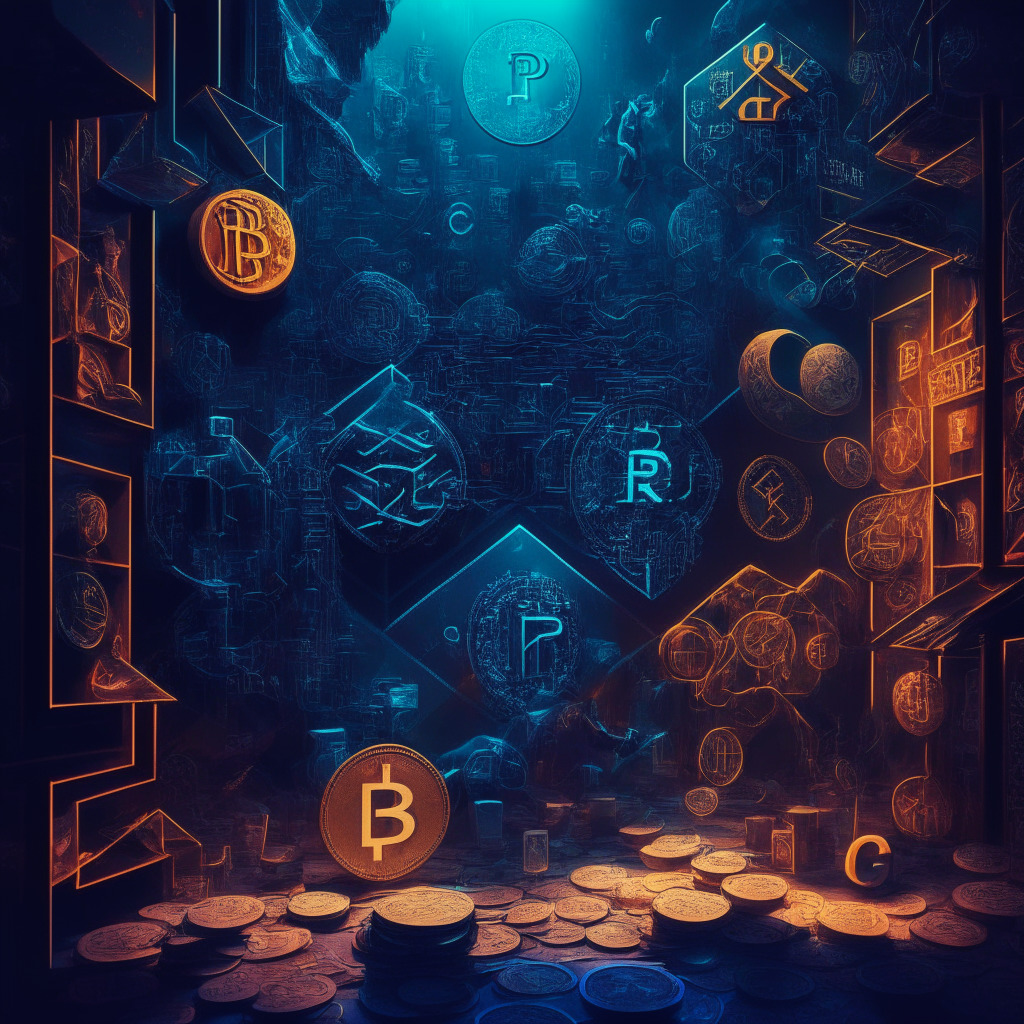“Arbitrum Foundation, a supporter of the Ethereum Layer 2 network, is partnering with Fracton Ventures to tap into the Japanese market. The alliance will focus on ecosystem construction and furnish community education, promoting Arbitrum’s adoption by Japanese developers and investors.”
Search Results for: Arbitrum Foundation
Arbitrum’s Swift DAO Maneuver: A Power Leap or a Fall into Uncertainty?
The Arbitrum Foundation recently transferred unclaimed tokens worth $56 million into their network’s decentralized autonomous organization (DAO) treasury. While offering new governance possibilities, this move also carries risks and obligations for token holders, speaks volumes about the future for Arbitrum’s users, and poses questions about the speed of tokenizing and redistributing actions within just six months of their DAO launch.
Unclaimed Tokens and a $59 Million Windfall: Arbitrum’s Unpredicted Odyssey
The Arbitrum Foundation recently transferred 69 million unclaimed ARB tokens to its treasury, amounting to $59 million and boosting it to nearly $3 billion in governance tokens. This successful move was through a vote proposed by a community member, demonstrating the impact of community engagement and decentralized operations. Meanwhile, Arbitrum’s user activity is growing along with efforts to expand the NFT space on its network.
Arbitrum’s Growth Despite ARB Token Downturn: Analyzing Factors and Future Prospects
Arbitrum’s governance token ARB faces downturn since its airdrop, but ecosystem growth remains healthy. Consistently higher daily active users, gas fees, and transaction count are observed. The upcoming Cancun-Deneb update featuring EIP-4844 and the Arbitrum Foundation’s revenue-sharing plan may impact ARB. Investors should conduct thorough research before making decisions.
Circle’s USDC Stablecoin Launch on Arbitrum: Impacts and Prospects for Blockchain Growth
Circle, a US-based payments firm issuing the USD Coin (USDC) stablecoin, is set to launch its coin natively on Arbitrum, an Ethereum scaling solution, on June 8th. This will provide benefits like maintaining a 1:1 exchange ratio with the US dollar, offering institutional on/off ramps, and supporting the forthcoming Cross-Chain Transfer Protocol (CCTP), which aims to eliminate bridge withdrawal delays.
Ethereum’s Bedrock Hard Fork: Optimism’s Game Changer or Arbitrum’s Continued Dominance?
The Ethereum blockchain will undergo the Bedrock hard fork on June 6 as Optimism, a layer 2 scaling solution, introduces a major upgrade for improved modularity, simplicity, and Ethereum equivalence. This is expected to increase performance and functionality, while fueling positive market sentiment for Optimism’s Layer 2 network.
Crypto Tokens as Securities: Ripple Case Study, Arbitrum Dilemma, and Canton Network Prospects
The crypto world continues to debate whether tokens are securities in the US, as companies like Ripple battle costly lawsuits from the SEC. Meanwhile, projects like the Arbitrum Foundation push boundaries, despite concerns that revenue distribution might label their tokens as securities, and major corporations form coalitions to create institutional blockchain solutions.
Coinbase’s Layer 2 Blockchain Surpasses Competitors: A Deeper Look into the FriendTech Phenomenon
Coinbase’s layer 2 blockchain, Base, sets record daily transactions, thanks to FriendTech, a decentralized social network platform built on Base. Despite a recent decrease, rekindled Base activity suggests network maturation. This strong start, unaffected by Ethereum’s congestion and fees, could indicate sustainable future growth with “layer-2” networks.
Sushi’s Blockchain Leap: Breaking Boundaries or Overextending its Reach?
Decentralized exchange Sushi is extending its services to non-Ethereum Virtual Machine compatible blockchain, Aptos, marking a major development. This strategic move could potentially attract fresh capital towards Aptos while enhancing cross-chain trading experiences and opening up new possibilities for liquidity across major blockchain networks.
Scaling the Ethereum Blockchain: The Promising Rise and Potential Pitfalls of Layer 2 Solutions
To combat increasing transaction times and fees, Ethereum is utilizing layer 2 scaling solutions, resulting in faster transaction speeds, lower costs, and maintaining security. These networks enhance throughput and transaction rates, drawing significant attention. However, layer 2 chains also face criticism, largely from crypto users maximizing profitability through airdrop farming.
Sei Blockchain’s Airdrop: Expectation Vs. Reality – A Lesson in Excessive Overreach
The much-anticipated airdrop by Sei blockchain on X (formerly Twitter) failed to meet expectations, leading to a substantial drop in SEI token’s market capitalization. Despite tripling the number of eligible wallets, the Sei Foundation faces backlash, suggesting a need to revisit its strategies.
SEI’s Market Momentum: Surges, Slumps, and Future Prospects of Cross-Chain Trades
“The Sei network, a new layer-one blockchain, saw its SEI token surge by 29% within a 24-hour span. The primary goal of Sei is to facilitate quick cross-chain trades and transactions. An airdrop of free SEI is planned, targeting users from various networks. Additionally, promising new altcoin Sonik Coin, based on Ethereum, offers staking rewards and engages investors with quirky marketing.”
Unveiling Base: Coinbase’s Disruptive Layer 2 Blockchain Safeguards and Its Mainnet Launch Challenges
“Base, Coinbase’s layer 2 blockchain, successfully passed a series of security audits ahead of its mainnet launch. Created with Optimism, Base aims to attract one million new crypto users. Over 100 experts examined its code, finding no significant vulnerabilities, reflecting Coinbase’s dedication to security.”
OpBNB Testnet: A Promising Solution for Scalability, Fees, and Speed in Blockchain Future
BNB Chain unveils opBNB testnet, an EVM-compatible blockchain with a target of 4,000 transactions per second and 0.005 U.S. cents per transaction. OpBNB aims to alleviate network congestion, reduce transaction costs, and improve scalability, offering a promising solution for efficient blockchain technology.
Decentralization Theater: Unmasking the Truth Behind Fake DeFi Projects and Ensuring a Genuine Future
In the world of DeFi, “decentralization theater” refers to projects appearing decentralized but retaining central control, confusing users and regulators. Genuine decentralization is vital for the development of Web3 ecosystems, disrupting the centralized Web2 architecture, and maintaining user trust.
Layer 2 Summer 2024: Ethereum’s Booming Future or Baseless Hype?
Ethereum enthusiast Anthony Sassano predicts a “Layer 2 summer” in the crypto market by next year, driven by technical advancements, reduced fees, and innovative projects. The anticipated improvements aim to make Layer 2 solutions more affordable and accessible, potentially attracting millions of new participants to the Ethereum ecosystem. However, the excitement comes with skepticism as potential risks and challenges tied to the technology persist.
Openfort’s Wallet-as-a-Service: Revolutionizing Crypto Gaming or Overhyping Infrastructure?
Crypto startup Openfort raised $3 million to develop its wallet-as-a-service software for game developers and publishers. Offering frictionless wallet technology via APIs, Openfort aims to simplify and enhance the gaming experience by abstracting cumbersome crypto transaction elements and supporting Ethereum-compatible networks.
Massive Crypto Selloff: Analyzing the Impact and How to Navigate Market Volatility
The global crypto market cap decreased by 2.60%, with over $182 million worth of crypto assets liquidated in 24 hours. Ethereum creator Vitalik Buterin selling 15,000 ETH is cited as the potential trigger for the crypto market selloff. Investors must conduct thorough market research and consider long-term prospects before making investment decisions in cryptocurrencies.

















